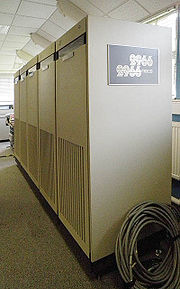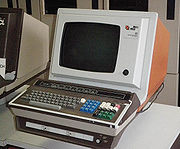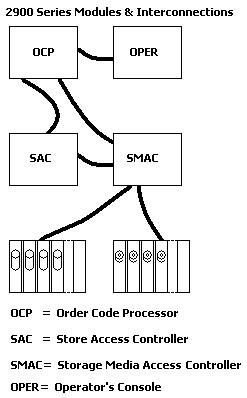
ICL 2900 Series
Encyclopedia

Mainframe computer
Mainframes are powerful computers used primarily by corporate and governmental organizations for critical applications, bulk data processing such as census, industry and consumer statistics, enterprise resource planning, and financial transaction processing.The term originally referred to the...
computer
Computer
A computer is a programmable machine designed to sequentially and automatically carry out a sequence of arithmetic or logical operations. The particular sequence of operations can be changed readily, allowing the computer to solve more than one kind of problem...
systems announced by the UK manufacturer ICL on 9 October 1974. The company had started development, under the name "New Range" immediately on its formation in 1968. The range was not designed to be compatible with any previous machines produced by the company, or with any competitor's machines: rather, it was conceived as a synthetic option combining the best ideas available from a variety of sources.
In marketing terms, the 2900 Series was superseded by Series 39
ICL Series 39
The ICL Series 39 was a range of mainframe and minicomputer computer systems released by the UK manufacturer ICL in 1985.- Origins :The Series 39 range was based upon the New Range concept and the VME operating system from the company's ICL 2900 line, and was introduced as two ranges:* Series 39...
in the mid-1980s; however, Series 39 was essentially a new set of machines implementing the 2900 Series architecture, as were subsequent ICL machines branded "Trimetra".
Origins
When ICL was formed in 1968 as a result of the merger ofInternational Computers and Tabulators
International Computers and Tabulators
International Computers and Tabulators or ICT was formed in 1959 by a merger of the British Tabulating Machine Company and Powers-Samas. In 1963 it also added the business computer divisions of Ferranti...
(ICT) with English Electric Leo Marconi, the company
considered a number of options for its future product line. These included enhancements to either ICT's 1900 Series
ICT 1900 series
ICT 1900 was the name given to a series of mainframe computers released by International Computers and Tabulators and later International Computers Limited during the 1960s and '70s...
or the English Electric System 4
English Electric System 4
The English Electric System 4 was a mainframe computer introduced in the mid-1960s. It was derived from the RCA Spectra 70 range, itself a clone of the IBM System 360 range. The models in the range included the System 4-10, 4-30, 4-50 , 4-70 and 4-75. ICL documentation also mentions a model 4-40...
,
and a development based on J. K. Illiffe's Basic Language Machine. The option finally selected was the so called Synthetic Option: a new design starting with a clean sheet of paper.
As the name implies, the design was influenced from many sources. These included ICL's own earlier machines. The design of Burroughs mainframes was influential, although ICL rejected the concept of optimising the design for one high-level language. The MULTICS
Multics
Multics was an influential early time-sharing operating system. The project was started in 1964 in Cambridge, Massachusetts...
system provided other ideas, notably in the area of protection. However, the biggest single outside influence was probably the MU5 machine developed at Manchester University.

The Virtual Machine
The 2900 Series architecture uses the concept of a Virtual Machine as the set of resources available to a program. The concept of a "Virtual Machine" in the 2900 Series architecture should not be confused with the way the term is used in other environmentsVirtual machine
A virtual machine is a "completely isolated guest operating system installation within a normal host operating system". Modern virtual machines are implemented with either software emulation or hardware virtualization or both together.-VM Definitions:A virtual machine is a software...
. Because each program runs in its own Virtual Machine, the concept may be likened to a process
Process (computing)
In computing, a process is an instance of a computer program that is being executed. It contains the program code and its current activity. Depending on the operating system , a process may be made up of multiple threads of execution that execute instructions concurrently.A computer program is a...
in other operating systems, while the 2900 Series process is more like a thread
Thread (computer science)
In computer science, a thread of execution is the smallest unit of processing that can be scheduled by an operating system. The implementation of threads and processes differs from one operating system to another, but in most cases, a thread is contained inside a process...
.
The most obvious resource in a Virtual Machine is the virtual store (memory). Other resources include peripherals, files, network connections, and so on.
Within a virtual machine, code can run at different layers of protection, called access levels (or ACR levels, after the Access Control Register which controls the mechanism). The most privileged levels of operating system code (the kernel) operate in the same virtual machine as the user application, as do intermediate levels such as the subsystems to implement filestore access and networking. System calls thus involve a change of protection level, but not an expensive call to invoke code in a different virtual machine. Every code module executes at a particular access level, and can invoke the functions offered by lower-level code, but cannot make direct access to memory or other resources at that level. The architecture thus offers a built-in encapsulation mechanism to ensure system integrity.
Segments of memory can be shared between virtual machines. There are two kinds of shared memory: public segments used by the operating system (which are present in all virtual machines), and global segments used for application-level shared data: this mechanism is used only when there is an application requirement for two virtual machines to communicate. For example, global memory segments are used for database lock tables. Hardware semaphore instructions are available to synchronise access to such segments. A minor curiosity is that two virtual machines sharing a global segment will use different virtual addresses for the same memory locations, which means that virtual addresses cannot safely be passed from one VM to another.
Addressing mechanisms
The 2900 architecture supports a hardware stack, providing an efficient vehicle for executing high-level language programs, especially those allowing recursive function calls. This was a forward-looking decision at the time, since it was expected that the dominant programming languages would initially be COBOLCOBOL
COBOL is one of the oldest programming languages. Its name is an acronym for COmmon Business-Oriented Language, defining its primary domain in business, finance, and administrative systems for companies and governments....
and FORTRAN
Fortran
Fortran is a general-purpose, procedural, imperative programming language that is especially suited to numeric computation and scientific computing...
. The architecture provides built-in mechanisms for making procedure calls using the stack, and special purpose registers for addressing the top of the stack and the base of the current stack frame.
Off-stack data is typically addressed via a descriptor. This is a 64-bit structure containing a 32-bit virtual address, plus 32 bits of control information. The control information identifies whether the area being addressed is code or data; in the case of data, the size of the items addressed (1, 8, 32, 64, or 128 bits); a flag to indicate whether hardware array-bound-checking is required; and various other refinements.
The 32-bit virtual address comprises a 14-bit segment number and an 18-bit displacement within the segment.
Technically the order code is not part of the 2900 architecture: this fact has been exploited to emulate other machines by microcoding their instruction sets. In practice, however, all machines in the 2900 series implement a common order code or instruction set, known as the PLI (Primitive Level Interface). This is designed primarily as a target for high-level language compilers.
There are a number of registers, each designed for a special purpose. An accumulator register (ACC) is available for general-purpose use, and may be 32, 64, or 128 bits in size. The B register is used for indexing into arrays; the LNB register points to the base of the current stack frame; the DR register is used for holding descriptors for addressing into the heap, and so on.
Data formats recognized by the PLI instructions include 32-bit unsigned integers; 32-bit and 64-bit twos-complement integers; 32-bit, 64-bit and 128-bit floating point; and 32-bit, 64-bit, and 128-bit packed decimal. Conventionally (and strangely to those tutored on C and UNIX) the boolean value true is represented as zero, false as minus one. Strings are held as arrays of 8-bit characters, conventionally encoded in EBCDIC
EBCDIC
Extended Binary Coded Decimal Interchange Code is an 8-bit character encoding used mainly on IBM mainframe and IBM midrange computer operating systems....
(though ICL's EBCDIC has minor variations from IBM's version).
Because some of the PLI instructions, notably those for procedure calling (especially system calls) are very powerful, instruction rates on 2900 Series are not always directly comparable with those on competitors' hardware. ICL marketing literature tended to use the concept of "IBM equivalent MIPS", being the MIPS rating of an IBM mainframe that achieved the same throughput in application benchmarks. The efficiencies achieved by the 2900 architecture, notably the avoidance of system call overheads, compensated for relatively slow raw hardware performance.
Implementations

The first machines announced in the 2900 Series were the 2980 and 2970. The 2980 allowed one or two order code processor
Order code processor
Order Code Processor is a term used in ICL 2900 Series and ICL Series 39 machines for central processing unit ....
s (OCPs), each operating at up to 3 million instructions per second, with real memory configurable up to 8 megabytes, with a 500 nanosecond access time.
The 2980 was initially the most powerful of ICL's New Range mainframe computers. In addition to the OCPs, it consisted of a store multiple access controller (SMAC) and one or more store access controllers (SAC), a general peripheral controller (GPC), one or more disc file controllers (DFC) and a communications link controller (CLC), together with disc drives (a typical configuration would have eight EDS 200 drives), tape decks, an operating station (OPER), line printers and card readers. It supported the VME/B, VME/K and Edinburgh Multiple Access System
Edinburgh Multiple Access System
The Edinburgh Multi-Access System was a mainframe computer operating system developed at the University of Edinburgh, Scotland, during the 1970s...
(EMAS) operating systems. A typical 2980 configuration would cost about £2 million.
Unlike the 2980, the 2970 and the subsequent 2960 were microcoded, and thus allowed emulation of instruction sets such as that of the older 1900 Series or the System 4.
A 2900 Series machine was constructed from a number of functional modules, each contained in a separate cabinet. Peripheral devices were connected using ICL's Primitive Interface (Socket/Plug and cable set) to a Port Adapter on the SMAC. Logical addressing was employed and used a group scheme to identify system components in terms of Ports, Trunks and Streams.
A Trunk was a generic name and a hardware address within a Port to which a peripheral controller would be assigned . A Trunk was a generic name for a controller for a number of Stream devices.A Stream was the generic name for the channel under which individual peripheral devices could be referenced.
The boot process for the 2960 Series is worthy of a special mention: the OCP contained a mini OPER terminal and a cassette deck. At boot, the OCP would perform its Initial Program Load (IPL) from the nominated IPL device . The IPL code provided the means for the OCP to discover the system's hardware configuration, by enquiring down the Stream(s), Trunk(s) and Port(s) to find the default or manually elected boot device for the microcode set and/or Operating System to be booted. This process was called a GROPE or General Reconnaissance Of Peripheral Equipment. The cassette load method also allowed engineering staff to load and execute diagnostic software.
See also
- VME - the operating system for the ICL 2900 Series, not to be confused with a (later) embedded operating system.
- Content Addressable File StoreContent Addressable File StoreThe Content Addressable File Store was a hardware device developed by International Computers Limited that provided a disk storage with built-in search capability...
(CAFS)
External links
An ICL 2966 machine from around 1982 is in the The National Museum of ComputingThe National Museum of Computing
The National Museum of Computing is a museum in the United Kingdom dedicated to collecting and restoring historic computer systems. The museum is based at Bletchley Park in Buckinghamshire, England, and opened in 2007...
at Bletchley Park
Bletchley Park
Bletchley Park is an estate located in the town of Bletchley, in Buckinghamshire, England, which currently houses the National Museum of Computing...
. More information can be found at:
Further photos of this machine are available at the following locations:
The cabinets in the foreground, labelled ED46, ED42, etc., are exchangeable disk drives; the plastic containers on top of the cabinets are used to hold the disks if they are removed from the drives. The larger containers holding more platters are 200Mb in capacity, the smaller would typically hold 40MB. The orange colour of the cabinets (officially "burnt tango") was the dominant colour used in ICL's corporate image at the time of the system's release.
- Reflections on the ICL 2900 series Historical anecdotes (Pink Mouse Productions)

